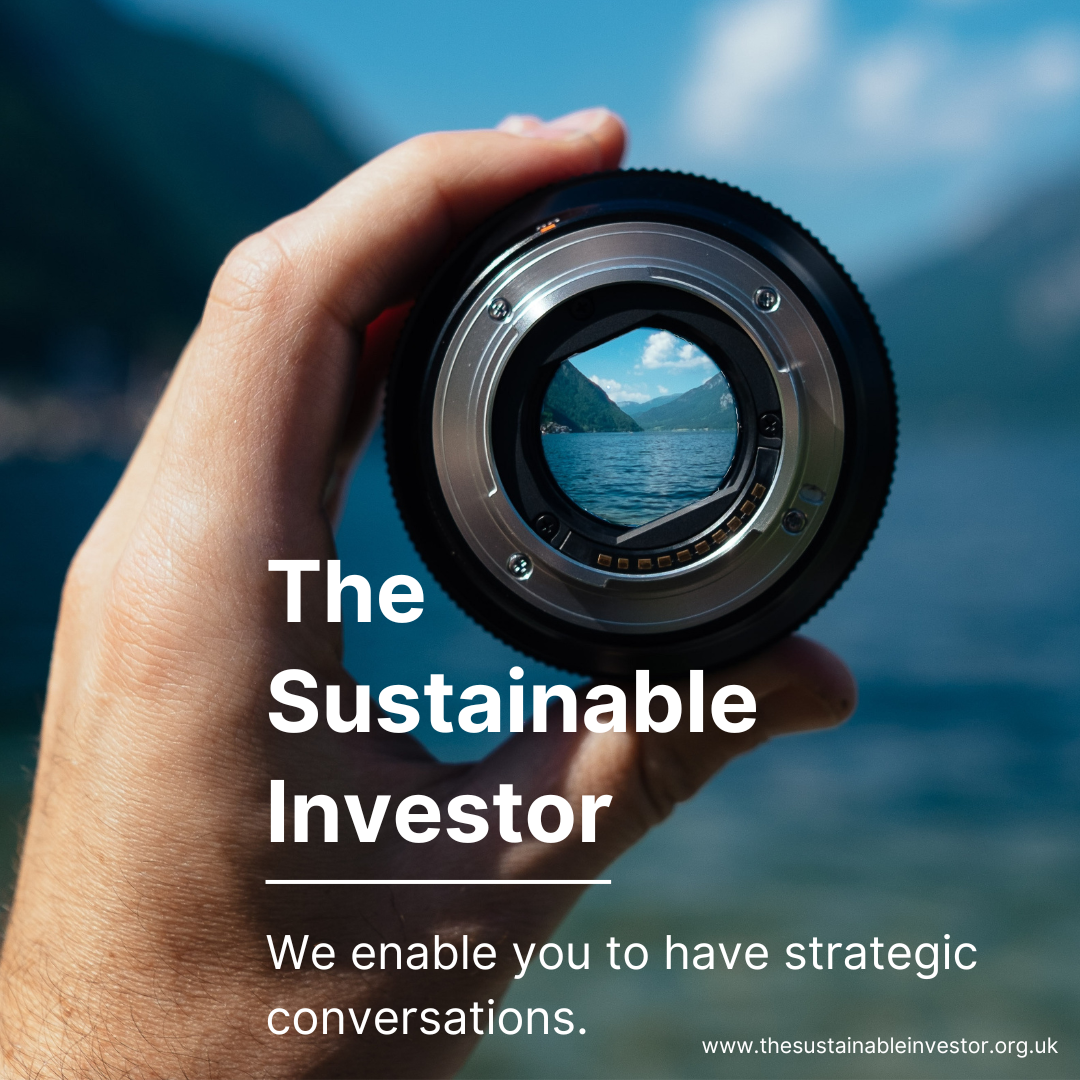
Is there such a thing as ESG investing?
ESG investing might be similar to traditional investing, but there are some important differences. The obvious one is how we select our investments. The less obvious, but equally important one is how we deal with the uncertainty of the geopolitics.
Summary: ESG and Sustainability investing might be similar to traditional investing (as argued by Alex Edmans et al) but there are also some important differences. The obvious one is how we select our investments. The less obvious, but equally important one is how we deal with the uncertainty of the geopolitics, the social, political, technological, regulatory and legal factors.
Why this is important: ESG investing will not save the world, and it probably will not create superior financial returns. But, it can still make a positive difference. But get the narrative wrong and you could find yourself investing in a dead end
“A non-sustainable company is unsustainable.” ― Fábio Pestana Bezerra

The details
I have a good friend who is a sustainability consultant. She is a recognised expert in her field, which happens to be supply chains. Most of her work is around validating existing supply chains, ensuring that the companies are not breaching best practice around issues such as modern slavery, deforestation, carbon emissions and worker rights.
Recently, she has noticed that more of her clients are shifting from what she describes as "making what they have compliant or better" to building entirely new supply chains. Some of the driver for this is customer demand, they want different products, and some of it is the risk of legal and regulatory action. The end result is that her job is changing, she now needs to fit what she does into the new company strategy. The old ways are changing.
This is bringing her more into contact with the financial world. The CFO/Finance Director and the finance team increasingly see supply chains as a source of strategic and financial competitive advantage. And investor relations and corporate communications are looking to find better ways of explaining the changes that are coming to their customers, employees, suppliers and investors. They want to get ahead of the curve. For her that means learning new skills and new ways of explaining and communicating - in this case about how the supply chain changes fit into the companies financial case.

Over the last year or so the two of us have talked a lot about how finance people think and make decisions, and it's not the way that many non financial people think. It's pretty clear that sustainability people and finance people live in different worlds, speak different languages and make decisions based on different factors. How can you bridge this ?
After much discussion, the framework that she has found that works the best is one of making decisions under conditions of uncertainty. It's an approach that the insurance and banking world already uses, but it's not often used in making investing and financial decisions. We think it should.
The traditional model in finance is one of creating financial forecasts and then using the outputs to identify the value of a project or asset. As an industry, we also understand the concept of risk, some cashflows are more risky than others. And this gives us a framework to include ESG factors - we largely treat them as risks to a company's business model and hence profitability.
So, what does all of this have to do with ESG investing. Unless you have been living under a rock for the last few years, you know it's an investment approach that has been put forward as a way of including our values in the investment appraisal process, and by implication, one that can cope with the inclusion of the impacts of the sustainability transitions. To quote from Forbes -"ESG investing is a strategy you can use to put your money to work with companies that strive to make the world a better place".
ESG investing is a growing "asset class". Just to take one example, a recent PwC report forecast that "ESG assets are on pace to constitute 21.5% of total global AuM in less than 5 years". Plus, we are seeing increasing regulation around what companies must report, and how asset managers can describe and market their funds. This raises the first important point, ESG investing (using ESG factors in our investment analysis) is different from ESG scoring, something that is often missed or misunderstood.
ESG investing is also an approach that has a lot of opponents, some of whom accuse it of promoting "woke capitalism".
However, a number of well regarded commentators, ranging from Alex Edmans (of London Business School and Grow the Pie fame), through the lawyer Paul Watchman, to even to a degree the arch ESG "critic"Aswath Damodaran (NY Stern), have argued that ESG investing, properly applied, is no different from ordinary investing.
Which is it? Is ESG investing really different, or is it just traditional investing, dressed up to make it more appealing to a new audience ? The answer is actually really important.
At the risk of ruining the surprise, we argue that while ESG investing has many similarities to traditional investing, there is an element that is different. This relates to understanding the future scenarios. Put simply ....
Lets dig down into this a bit more....
What do the critics mean when they say that ESG investing is just the same as traditional investing?
Put simply, in much the same way that we would not carry out a financial evaluation of say a technology company without thinking about the value of its intellectual property (what are called intangible assets), we should obviously also include Environmental, Social and Governance factors in our analysis of all companies, but only when they are material to the company's value.
As Alex Edmans put it in his now famous article "The End of ESG" ....
"ESG is both extremely important and nothing special. It's extremely important because it's critical to long-term value, and so any practitioner or academic should take it seriously, not just those with "ESG" in their job title or list of research interests. Thus, ESG doesn't need a specialized term, as that implies it's niche. Considering long-term factors when valuing a company isn’t ESG investing; it’s investing. But, its also nothing special since it's no better or worse than other intangible assets that drive long-term value and create positive externalities for wider society, such as management quality, corporate culture, and innovative capability."
The obvious conclusion you could draw from this is that the current political storm over ESG will pass. People making financial decisions, so companies, investors and the underlying providers of capital, will end up naturally taking account of the ESG factors that impact the value of their investments. And of course, ignore those that don't.
Unsurprisingly, this view has had some push-backs. ESG investing, at least in its current form, grew out of a belief that the financial industry can act to help make the work a better place, and still generate a fair financial return. The argument is that some beneficiaries of our investing activities actually care about more than maximising financial return, people are willing to forgo a level of financial return to deliver on positive environmental or social outcomes. One piece of "evidence" supporting this is the growth in assets allocated to ESG funds, the argument being that this shows people do want to make a difference.
This concept of wanting to help the greater good has been tested, and it seems to hold up, at least in some cases. For instance a study in The Netherlands (reported in 2021) showed that members of a pension fund were willing to increase sustainability activities even it it meant lower financial returns. And a study led by the University of St Gallen showed that some investors have a willingness to pay for sustainable investments, but not a willingness to pay more for more good. A lot more work is needed in this area, but you get the drift.
We want to come at the debate in a different way. Lets start with how an investment appraisal actually works. This is a simplification, hence we apologise to those of you who (as we did) do it for a living.
The place to start is with our investible universe. For a fund manager, this will be the terms of their mandate, what they say they do and don't invest in. For a company it's about projects that positively contribute to delivering on the company's strategy. When we worked as portfolio managers we frequently managed mandates that had exclusions - no tobacco, no gambling and often no weapons. These days it might also include full or partial exclusions based on a company's ESG score. On exclusions, the jury is definitely out on the question of do they make any difference in practice - a topic I want to return to.
From within this investible universe, you then look to select investments that will perform financially better than your benchmark (being the financial index that your performance is measured against). I don't propose to go into detail how this was done, but broadly the process is normally one of building some sort of financial model, and then valuing the cashflows or profits that you thought the company/project would generate. Copeland, Koller & Murrin from McKinsey made a good living describing one approach in their book, simply entitled Valuation, Measuring & Managing the Value of Companies.
My experience has been that most analysts start their forecasts with how the company looks currently, and then project forward. Or putting it another way, they assume that the future will look a lot like the present. A companies positioning in the market will change only slowly, and new entrants are unlikely to appear with different/better business models.
While this approach sometimes works, it often doesn't. Lets look at companies such as video rental company Blockbuster, and mobile phone market leader Nokia ... maybe adding in J C Penny and General Electric Co for good measure. All were leaders in their industries at one time, and now are either in bankruptcy (Blockbuster in 2010, J C Penny in 2020) or a shadow of their former selves (Nokia share price peaked at US$53.7 in 2000, now c. US$4.7 & the GE share price in 1999 was once US$352, its now c. US$78).
One common thread that runs through all of these cases is not anticipating and preparing for change - the growth of internet retailing, the emergence of smart phones in telecoms, and the move away from gas turbines in power generation. On the other side we could have picked the growth of Amazon, or Microsoft or Apple. Companies who saw, and then positioned themselves for the change.
What has this to do with ESG and Sustainability investing?

We argue that the sustainability transitions are going to bring massive change to most businesses. The energy sector (Oil & Gas especially) gets a lot of attention, but the transitions are going to impact nearly all aspects of our lives. This includes ...
Agriculture and natural capital - the food we eat, how it is grown and processed, where we purchase it from and how we act to protect our natural habits. This will also include our efforts to protect our natural environment and biodiversity
Built environment - our buildings, and how we keep them at an appropriate temperature, our cities and our infrastructure
Electricity systems - how we generate, transport and store electricity, and how we use it.
Our industrial systems - how we produce essential goods such as steel, cement and the new technologies of solar, wind and batteries. Plus, where we source the raw materials from (our metals and mining supply chains).
Our health & wellness - how we protect and enhance our health, our air and water and the fundamental human rights.
This list is not exhaustive. It could also includes our clothes, our household goods and our transport systems, plus of course all of our financial infrastructure, our banks and investment companies that allocate capital, but hopefully you get our drift.
The future world will look very different from the present, it's going to impact most companies, and it's likely that the change will take place a lot faster than we expect.
This change has massive implications for our companies. They have invested in building up certain competencies and expertise, tools that they use to create competitive advantage and to generate profits. Some of this is from physical things we can kick & touch - factories, ships and warehouses. But most of it is in systems and knowledge, what we call intangibles. They have not only created software and IT systems, they have also built up skills in processes, how to best provide a good or service. These skills are often being constantly refined and improved. These intangibles are often what makes one company better than its peers.
Now imagine a world where the way we produce our goods and services changes dramatically, where the skills and expertise you have built up no longer have value.

So returning to our financial modelling example, how do we include this ? Some industries are used to this type of rapid change. Tech companies have to reinvent themselves on a regular basis. Take search engines. Google (owned by Alphabet Inc) is now pretty dominant, but who remembers Open Text, Magellan and Direct Hit. But most industries do not work this way, change is slow and while their competitors wax and wane, the industry structure broadly stays, if not the same then very similar.
Now, you might argue, as commentators such as Michael Mauboussin and Aswath Damodaran do, that we should include change in our analysis. To borrow from Damodaran's book, Narrative & Numbers ...
"a valuation that is not backed up by a narrative is both soulless and untrustworthy"
Yes, narratives on their own are dangerous. Stories that we don't test against numbers can allow us to easily wander into fantasy land, where we allow our hopes and dreams to lead us into foolhardy investments. But, we argue that we need narratives to test our thinking, to give us a meaningful foundation for our numbers, our financial work. And we need narratives to better communicate our analysis and thinking to others - our lenders, our investors, our customers and our work colleagues.
My experience is that this seldom happens, most financial analysts don't use this combination of narrative and numbers. To again quote Damodaran
" from an early age, the world divides us into story tellers and number cruncher's" and we seldom get to join the two parts back together again.
Hopefully by now you can see where I am going with this. I perfectly understand what Edmans, Watchman, Damodaran and others are saying. The values part of ESG gets dealt with in how we select our investible universe, this is where our desire to reduce carbon emissions or preserve our oceans gets included. After that it should just be like traditional investing.
But, we argue that this normally means that something gets missed. If we don't have a sensible narrative, we don't really have a way of building in the social, technological, political and regulatory changes that the sustainability transitions will bring. To build this narrative, we need to understand what is likely to drive the changes, how they might develop, which solutions are most likely to succeed, what barriers they face and how quickly this might happen. And how we can anticipate and proactively respond, pushing the companies we work in and the investments we make toward better outcomes.
This is not about science fiction type forecasting, flying cars and impossibly cheap energy. Its about taking what we already know about, things that already work, or are close to working, and test how they can be applied in different situations. The finance world works in silo's, sometimes the solution is just to take lessons from one silo and apply them to another, thinking horizontally not vertically. As William Gibson put it: “The future has arrived — it’s just not evenly distributed yet.”
Conclusions
We have argued that while ESG and sustainability investing has similarities to traditional investing, there are also some material differences. The obvious one, that we currently focus most attention on, is how do we select our investible universe. Here we need to be clear about the criteria we use, something that is often lacking. This is not just a question for asset managers, asset owners need to think deeply about this (what outcomes do they want), and companies have their own form of screening, what projects are aligned with our strategy.
But then we have the less obvious difference. ESG investors, and companies, need to have a clear narrative around their investing choices. How are social, regulatory, political, legal, competitive, and technological changes going to impact on our company or project in the future, what issues do we particularly need to look out for, and how/why might the future be different from that we are currently expecting. This is something that should be done for all investments, but often is not. Its absence is sometimes not a problem for many traditional investments, but in sustainable investing, it can be everything.
Get the narrative wrong and you could find yourself investing in a dead end, the Betamax of the future. Plus, it gives you a solid platform for your engagement - a topic for a future blog.
Something a little more bespoke?
Get in touch if there is a particular topic you would like us to write on. Just for you.
Contact us
Please read: important legal stuff.

